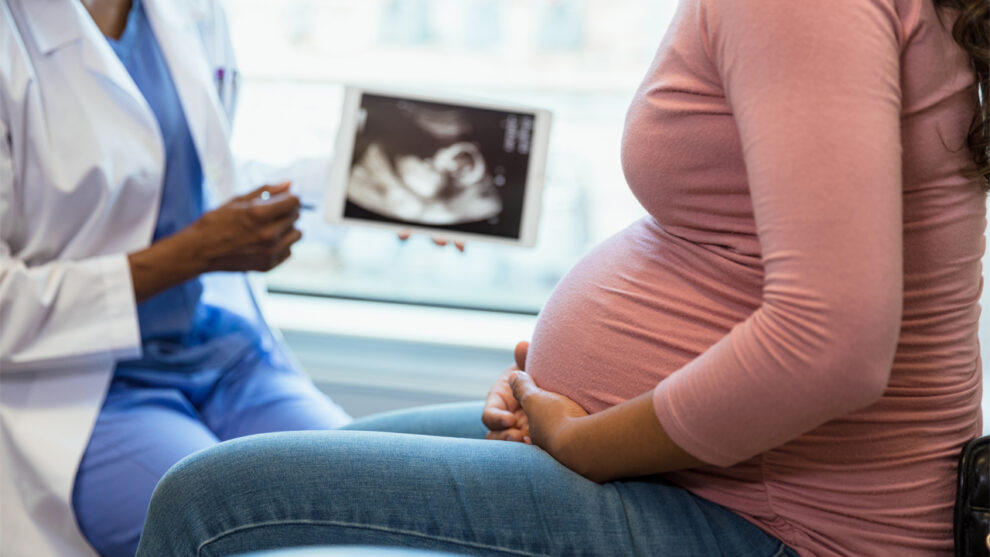A study presented Oct. 9 by University of North Carolina (UNC) School of Medicine researchers at the XXIV FIGO World Congress of Gynecology and Obstetrics could revolutionize pregnancy care, especially in areas with limited resources. The study (FIGO Oral Abstract #FC01) establishes the diagnostic accuracy of an innovative new ultrasound AI algorithm for determining gestational age—a fundamental measurement essential to good pregnancy care.
This new research demonstrates that providers with no prior training in sonography can accurately estimate a baby’s gestational age using a handheld device powered by AI. The study employed machine learning algorithms developed at the University of North Carolina at Chapel Hill that were incorporated into the software of Butterfly Network’s handheld ultrasound system, Butterfly iQ+. The combination of AI tools with portable and affordable devices promises to make ultrasound widely available in any global health context and at every access point to health care for pregnant women around the world.
Led by Jeffrey Stringer, MD, professor of obstetrics and gynecology at the UNC School of Medicine, an interdisciplinary team from the UNC Institute for Global Health and Infectious Diseases and the University of Zambia School of Medicine conducted a study involving 400 pregnant women in Chapel Hill and Lusaka.
“Ultrasound is like a stethoscope to the obstetrician. We use it all day, every day,” explained Stringer, who conceived the project when he and his wife worked as obstetricians in Lusaka, Zambia. “This new tool allows anyone to perform an ultrasound. Just sweep the probe across the woman’s belly a few times and the AI does the rest.”
The study and findings
Investigators recruited pregnant women (200 from each country) in early pregnancy and definitively established their gestational age. They were then assigned return visits at random dates within defined evaluation windows, during which users with no prior ultrasound training obtained blind sweeps with the Butterfly iQ+, equipped with the AI tool created by the UNC team. Expert sonographers also performed standard of care fetal biometry with high-specification ultrasound machines. The previously established gestational age was masked to both sonographer groups.
During the primary evaluation window of 14 to 27 weeks, untrained providers using the Butterfly device and AI tool produced gestational age estimates that were equivalent to an expert sonographer using a high specification machine, with a mean absolute error of 3.19 ± 0.13 days for the AI tool versus 3.04±0.12 days for expert biometry (difference: 0.2 days; 95% CI: -0.1 to 0.4 days). During the secondary evaluation window of 28 to 36 weeks, the AI gestational age tool met criteria for superiority, beating the expert estimate by approximately one day.
The two evaluation windows represent the range of gestational age where some 80% of women living in resource-limited settings first present for pregnancy care. The results indicate that the simple AI tool coupled with the ButterflyiQ+ device is just as accurate in estimating the baby’s gestational age as an expert sonographer using a machine. More information about the study can be found at clinicaltrials.gov (NCT05433519).
What this means for maternal health equity
“This technology suggests a future where high-quality pregnancy care, including the crucial first scan, could be accessible to all women, regardless of their location or the resources available to them,” said Myron Cohen, MD, Director of the UNC Institute for Global Health and Infectious Diseases. “It also demonstrates the mutually beneficial nature of global health research that can improve the delivery of health care services both abroad and close to home.”
The World Health Organization recommends an ultrasound scan before 24 weeks’ gestation for all pregnancies. More than 12 million scans are performed each year in the U.S., with the average pregnant woman receiving three to four ultrasounds during pregnancy, or more, for complicated pregnancies. But in low-resource settings like Zambia, which is typical of care systems across sub-Saharan Africa and parts of Asia, the high cost for equipment and the need for trained sonographers to perform scans means that very few women have access to ultrasound.
In rural parts of the U.S., including areas of North Carolina, women may face lengthy travel to access obstetric care with trauma centers and obstetric units closing. For pregnant women, this could mean more births outside of hospitals, births in hospitals without OB care, and preterm births—all of which carry greater risks for a mom and baby.
In a future where this AI-enabled Gestational Age Tool is broadly available, not only could gestational age evaluation become significantly faster, but clinical care choices could be made immediately at the point-of-care—avoiding further delays and costs in an already overburdened system.
Source : Medical Xpress











